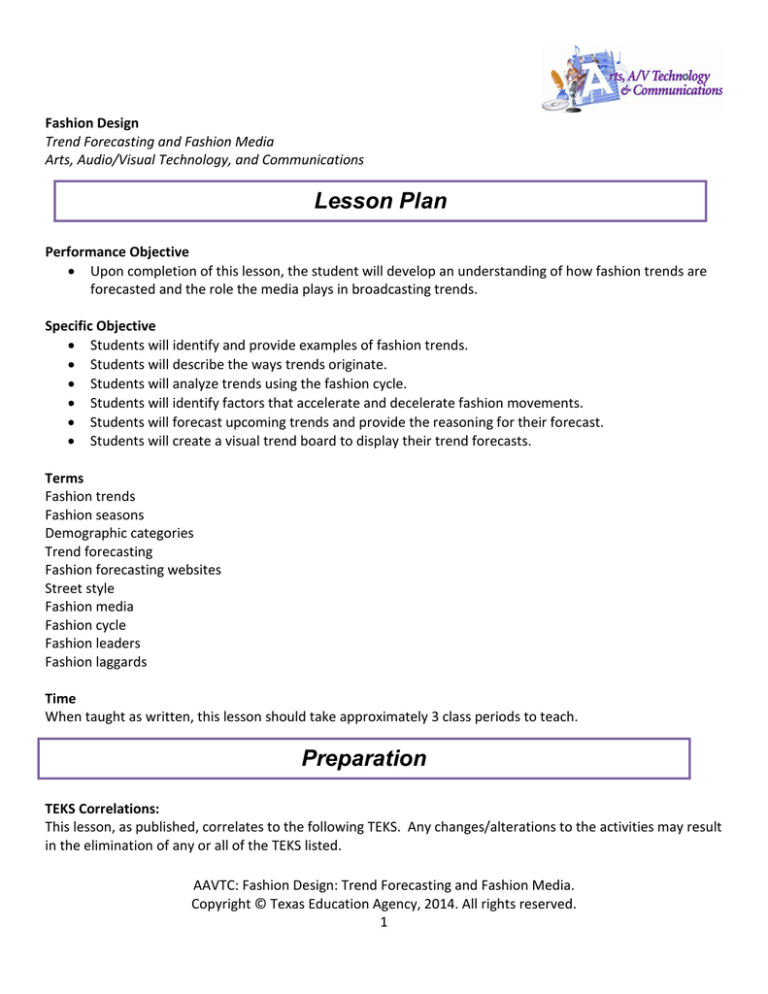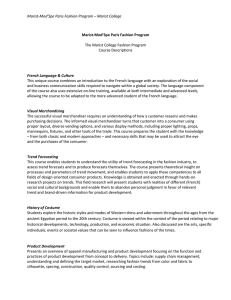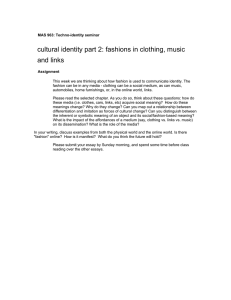Lesson Plan
advertisement

Fashion Design Trend Forecasting and Fashion Media Arts, Audio/Visual Technology, and Communications Lesson Plan Performance Objective • Upon completion of this lesson, the student will develop an understanding of how fashion trends are forecasted and the role the media plays in broadcasting trends. Specific Objective • Students will identify and provide examples of fashion trends. • Students will describe the ways trends originate. • Students will analyze trends using the fashion cycle. • Students will identify factors that accelerate and decelerate fashion movements. • Students will forecast upcoming trends and provide the reasoning for their forecast. • Students will create a visual trend board to display their trend forecasts. Terms Fashion trends Fashion seasons Demographic categories Trend forecasting Fashion forecasting websites Street style Fashion media Fashion cycle Fashion leaders Fashion laggards Time When taught as written, this lesson should take approximately 3 class periods to teach. Preparation TEKS Correlations: This lesson, as published, correlates to the following TEKS. Any changes/alterations to the activities may result in the elimination of any or all of the TEKS listed. AAVTC: Fashion Design: Trend Forecasting and Fashion Media. Copyright © Texas Education Agency, 2014. All rights reserved. 1 130.93. Fashion Design. (c) Knowledge and Skills. (1) The student applies academic knowledge and skills in fashion, textile, and apparel projects. The student is expected to: (A) apply English language arts knowledge and skills by demonstrating use of content, technical concepts, and vocabulary; using correct grammar, punctuation, and terminology to write and edit documents; and composing and editing copy for a variety of written documents such as patterns, brochures, advertisements, and press releases. (2) The student applies professional communication strategies. The student is expected to: (C) interpret and communicate information, data, and observations (10) The student develops an understanding of fashion and the textile and apparel industries. The student is expected to: (A) analyze the nature and scope of fashion by: (iv) identifying prominent fashion publications; (v) summarizing the fashion process (D) analyze factors that impact consumer purchases of fashion and apparel accessories by: (i) describing social, cultural, and life cycle influences of fashion and apparel preferences and management; (ii) explaining how fashion trends are determined Interdisciplinary Correlations: 110.32. English Language Arts and Reading, English II (9) Reading/Comprehension of Informational Text/Expository Text. Students analyze, make inferences and draw conclusions about expository text and provide evidence from text to support their understandings. Students are expected to: (C) make and defend subtle inferences and complex conclusions about the ideas in text and their organizational patterns (12) Reading/Media Literacy. Students use comprehension skills to analyze how words, images, graphics, and sounds work together in various forms to impact meaning. Students will continue to apply earlier standards with greater depth in increasingly more complex text. Students are expected to: (A) evaluate how messages presented in the media reflect social and cultural views in ways different from traditional texts. (15) Writing/Expository and Procedural Texts. Students write expository and procedural or workrelated texts to communicate ideas and information to specific audiences for specific purposes. Students are expected to: (A) write an analytical essay of sufficient length that includes: (v) relevant evidence and well-chosen details. Occupational Correlation (O*Net – www.onetonline.org/): Job Title: Fashion Designer O*Net Number: 27-1022.00 Reported Job Titles: Apparel Fashion Designer, Clothing Designer, Costume Designer, Product Developer Tasks: Direct and coordinate workers involved in drawing and cutting patterns and constructing samples or finished garments. AAVTC: Fashion Design: Trend Forecasting and Fashion Media. Copyright © Texas Education Agency, 2014. All rights reserved. 2 Examine sample garments on and off models, modifying designs to achieve desired effects. Sketch rough and detailed drawings of apparel or accessories, and write specifications such as color schemes, construction, material types, and accessory requirements. Confer with sales and management executives or with clients to discuss design ideas. Identify target markets for designs, looking at factors such as age, gender, and socioeconomic status. Provide sample garments to agents and sales representatives, and arrange for showings of sample garments at sales meetings or fashion shows. Soft Skills: Active listening, speaking, writing, social perceptiveness, judgment and decision making Accommodations for Learning Differences It is important that lessons accommodate the needs of every learner. These lessons may be modified and/or accommodated to your students with learning differences by referring to the files found on the Special Populations page of this website. Preparation • Review and familiarize yourself with the terminology. • Search online for fashion trend forecasting and appropriate website links • Collect several fashion magazines as examples of fashion trends • Have materials and websites ready to go prior to the start of the lesson. References 1. Calasibetta, C. M., & Tortora, P. (2003). The Fairchild dictionary of fashion (3rd ed.). New York: Fairchild Publications, Inc. 2. Wolfe, M. (2009). Fashion marketing and merchandising (3rd ed.). Tinley Park, IL:The Goodheart-Willcox Company, Inc. Instructional Aids • Lesson Plan: Trend Forecasting and Fashion Media • Slide Presentation: Trend Forecasting and Fashion Media • Assignment Rubric • Trend Forecasting and Fashion Media Notes Handout • Trend Forecasting and Fashion Media Assignment • Instructor Computer/Projection Unit • Online Websites and Fashion Magazines with examples of Fashion Trends • Student computers, tablets, or smart phones • Poster board, copy paper, glue, scissors AAVTC: Fashion Design: Trend Forecasting and Fashion Media. Copyright © Texas Education Agency, 2014. All rights reserved. 3 Introduction Introduce the lesson by discussing characteristics of fashion trends. Ask students to identify and describe some fashion trends from the current season. Which ones did they experience personally? Which ones do they think were the most popular and why? Ask students if they can recall any fashion trends from the previous season or the previous year. What makes these fashion trends memorable? Ask students if they can remember how they were aware of particular trends or if they can remember what factors influenced them to accept those trends. Discuss possible ways that trends are started and sustained. Allow students to work in groups and peruse various fashion magazines. Have each group make a list of characteristics they noticed (regarding fashion trends) as they looked through the various magazines. Discuss students’ observations. Discuss how fashion trends can be forecasted for upcoming seasons. Show some examples of appropriate websites on fashion trend forecasting and discuss some of the highlights of these websites. AAVTC: Fashion Design: Trend Forecasting and Fashion Media. Copyright © Texas Education Agency, 2014. All rights reserved. 4 Outline MI Outline Instructor Notes Go through the Slide Presentation with students. Discuss the following: I: Overall Objectives a. What students will learn b. How students will demonstrate their learning Begin Slide Presentation here. Slide 2: Discuss what students will learn in this lesson. II. Fashion Trends a. What they are b. Examples Slide 2: Be sure students understand that trends touch all areas of fashion, not just clothing III. What are the Fashion Seasons? IV. What are the Fashion Categories? V. Where do Trends Come From? VI. Fashion Forecasting Websites VII. Street Style a. What it is b. Examples VIII. Fashion Media Slide 3: Students will participate in a “trend-spotting” activity (See Guided Practice). Slide 6: Discuss what it takes to not only start a trend, but sustain a trend. Why is this important? Slide 7: The class will perform a trend forecasting activity (See Guided Practice). IX. Fashion Cycle X. Fashion Leaders and Laggards XI. Factors that Accelerate a Movement XII. Factors that Decelerate a Movement XIII. Description of Student Project AAVTC: Fashion Design: Trend Forecasting and Fashion Media. Copyright © Texas Education Agency, 2014. All rights reserved. 5 Multiple Intelligences Guide Existenti alist Interpers onal Intrapers onal Kinesthe tic/ Bodily Logical/ Mathema tical Musical/Rhyt hmic Natura list Verbal/Ling uistic Visual/Sp atial Application Guided Practice Throughout the slide presentation, the teacher will stop periodically for the class to participate in short activities. • For Slide #3, the class will perform a trend spotting activity. Students may work in groups of 3-4. Students should consider individual observations but record their findings as a whole. Student groups should brainstorm together to come up with a list of current fashion trends they have seen on campus. Teacher may encourage brainstorming process by prompting questions such as: What types of shoes are popular right now? What colors do you see the most on girls? Boys? What brands do you notice the most? What is worn on casual days? What do most teens wear when they want to dress up? Once student groups have compiled their list of current trends, teacher can gather their findings and record them all on the board. • For Slide #7, the class will perform a trend forecasting activity. The teacher may do an online search for a trend forecasting website. The trend forecasting website should be displayed by projector so students can see what trends are first publicized on the site. Encourage students to give their feedback on what they think of trends forecasted. Teacher may engage student participation by asking questions such as: Do you think students at this school will wear that next season? What type of person (profession, age range, etc.) would be the most likely to wear this trend? What stores do you think will sell this trend? How long do you think the trend will last? The class will view and discuss information posted on the fashion trend forecasting website. Independent Practice • Assign or allow students to choose a season and demographic category to research. o Students will choose a specific fashion season o Students will choose three demographic categories/sub-categories for researching forecasted trends • Students will use a search engine to research forecasted trends for their chosen fashion season/year and demographic category/sub-category o Students will list six findings on the assignment page. o Each recorded trend must also have its source cited. • Students will hypothesize whether each trend will be a flop, fad, normal trend, or a classic based on their research and observations. AAVTC: Fashion Design: Trend Forecasting and Fashion Media. Copyright © Texas Education Agency, 2014. All rights reserved. 6 • • Students will state a supportive claim for each prediction. Students should consider factors that accelerate or decelerate the fashion movement and the fashion cycle for this step. Students will create a visual trend board to post their trend forecasts. Students may use any media outlet available to them, such as posts on social media, fashion blogs, display a poster board at school, or a flyer. o Trend report must be publicized and must include: fashion season and year, demographic category/subcategory, 3 forecasted trends, each with a descriptive title, a picture, a label as a fad, normal, or classic, and a supportive claim. Summary Review Review and discuss fashion trends forecasted and forecast label predictions. Evaluation Informal Assessment Any and all of the following can be used as informal assessments… • Check student participation in guided practice • Prompting • Check progress of student assignment Formal Assessment Any and all of the following can be used as formal assessments… • • • Required notes filled out completely and accurately Student project assessment using attached rubric Class presentation of completed projects Enrichment Extension: Students may hypothesize what the upcoming fashion trends will be and which retailers will be “Leaders” in upcoming trends. Students may also like to consider and predict the price range for various fashion trends. AAVTC: Fashion Design: Trend Forecasting and Fashion Media. Copyright © Texas Education Agency, 2014. All rights reserved. 7 TREND FORECASTING AND FASHION MEDIA NOTES PAGE Name: ______________________________________ Date: _________________________ Directions: Fill in the blank spaces with the information given during the slide presentation. • Fashion trends are the __________________ in which styles, ____________, fabrics, and ____________ are trending to change. • Trends show up on _____________, ____________, bags/purses, jewelry, make-up, hair, etc. • Trends are forecasted __________ to _______________ in advance, according to a fashion season. The 2 fashion seasons are ____________________________________ and __________________________________. Fashion Demographics _______________________ _______________________ _______________________ Sub-category: _____________________________ ______________________________ ______________________________ ______________________________ ______________________________ ______________________________ ______________________________ Trickle-down theory description: Trickle-up theory description: Trickle-across theory description: Each new trend moves through the fashion cycle. Write a description for what each term means in regards to how it moves through the fashion cycle. AAVTC: Fashion Design: Trend Forecasting and Fashion Media. Copyright © Texas Education Agency, 2014. All rights reserved. 8 Flop – __________________________________________________________________ Fad – ___________________________________________________________________ Normal trend – ___________________________________________________________ Classic - _________________________________________________________________ Factors that accelerate the fashion movement Factors that decelerate the fashion movement AAVTC: Fashion Design: Trend Forecasting and Fashion Media. Copyright © Texas Education Agency, 2014. All rights reserved. 9 TREND FORECASTING AND FASHION MEDIA ASSIGNMENT DIRECTIONS: Search online for upcoming fashion trends. Create a trend board for your fashion predictions. STEP 1: Write the fashion season and year you will research: __________________________ STEP 2: Target three demographic categories/sub-categories to use in creating your trend board: _________________________ _________________________ _________________________ STEP 3: Do an online search for a trend for your chosen season and demographic category. Use a search engine and type in “trend forecast for _____________.” (In the blank enter your season, year, and a demographic category that you wrote in steps 1 & 2). Look for websites that are labeled with keywords such as “Fashion trend forecasting and analysis” or “trend forecast reports.” STEP 4: List 6 trends that you find online. Trends may be a combination of colors, prints, apparel styles, textures, images, etc. Make sure to write down the website source for each finding. Trend Category Forecasted Source 1 2 3 4 5 6 AAVTC: Fashion Design: Trend Forecasting and Fashion Media. Copyright © Texas Education Agency, 2014. All rights reserved. 10 STEP 5: From your above list of trends, identify which ones you think will be a flop, fad, normal cycle, or classic. Write a 1-2 sentence supportive claim telling why you labeled your prediction as such. Trend number 1 Prediction Supportive Claim (I think it will be a ______ because….) 2 3 4 5 6 STEP 6: Use a media outlet available to you to publish your trend forecast report. In your trend report, you will need to identify one trend as a potential “fad,” another as “the normal cycle,” and one other that you think will remain a “classic.” Potential media outlets include: Posts on social media, post on a fashion blog, create a poster board to display at school, create a flyer using a word processing document. Regardless of the format you decide to use to create your trend report, it should contain the following information: • • • Fashion season and year Demographic category 3 forecasted trends….each must have: o Descriptive title o 1 picture o Label that is one of the following: “Forecast: Fad” “Forecast: Normal Cycle” “Forecast: Classic” o Supportive claim AAVTC: Fashion Design: Trend Forecasting and Fashion Media. Copyright © Texas Education Agency, 2014. All rights reserved. 11 TREND FORECASTING AND FASHION MEDIA ASSIGNMENT RUBRIC Criteria Exceptional Above Average Below Average Unacceptable Completeness 20-15 points 14-8 points 7-1 points 0 points (20 pts) Work is 100% complete; all pieces fit together as complete whole Work is complete; pieces are present but do not present a unified look Work is incomplete; pieces are inconsistent and difficult to follow Very little to no attempt is made to complete project Creativity 15-11 points 10-6 points 5-1 points 0 points (15 pts) Work is presented in an aesthetically pleasing format Work is complete with a creative attempt that is not present throughout the entire project Work has little creative effort Work is performed in haste with no creative effort Trend Forecasts/ Supportive Claim 30-22 points 21-12 points 11-1 points 0 points Trend forecasts are documented completely with picture, description, label of fad, normal, and classic, and a supportive claim Forecasts are documented with 75% information presented Forecasts are documented with 50% information; claims do not support trend label Forecasts do not have pictures, descriptions, labels or supportive claims 25-18 points 17-10 points 9-1 points 0 points Report is posted in common viewing space for a duration of at least 1 week Report is posted in a place not easily viewed for a duration of at least 1 week Report is posted in a place not easily viewed for less than 1 week Report is not posted 10-8 points 7-4 points 3-1 points 0 points Report is put together in an organized and easy to read format Report is somewhat organized; information is scattered in report Report shows little organization; it is not prepared for the reader Report is not prepared to be viewed by reader (30 pts) Published report (25 pts) Professional Appearance (10 pts) Comments: Total points: AAVTC: Fashion Design: Trend Forecasting and Fashion Media. Copyright © Texas Education Agency, 2014. All rights reserved. 12 Points


